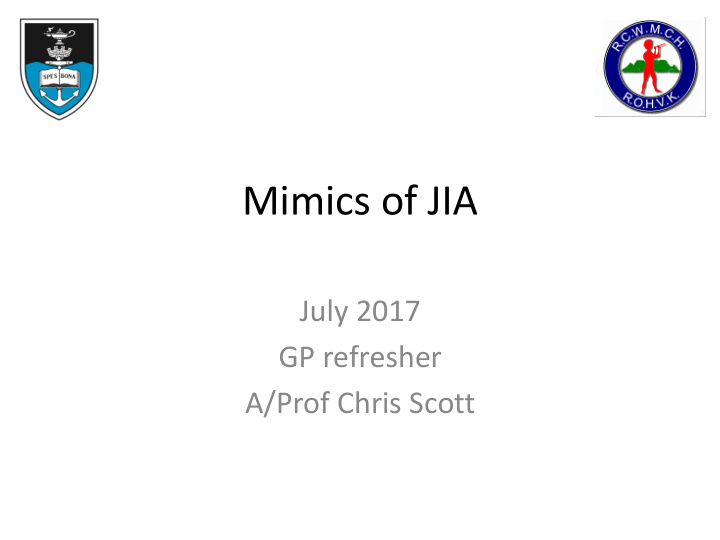



Mimics of JIA July 2017 GP refresher A/Prof Chris Scott
Getting to know you … How many of you have seen children with Juvenile Idiopathic arthritis? How many of you routinely examine the MSK system? How many of you are confident in examining the joints of children? How many of you had dedicated teaching on JIA in med school?
Introduction • In a prospective study from The Royal Hospital for Sick Children, Edinburgh, every 58th child presented with an acute atraumatic limp. • A survey of adolescents in British Columbia revealed that musculoskeletal complaints were perceived as the 2 nd most common health concern after acne. Juvenile Arthritis is the most common cause of musculoskeletal disability in children. • Musculoskeletal pain can be the presenting feature of many different conditions, including life threatening conditions Fischer SU..1999 Foster & Cabral, 2006
Is JIA common • How many of you agree Septic with this statement arthritis: 1/300 – IDDM is more prevalent than JIA in children? – Septic arthritis is IDDM: more common than 1/300 JIA JIA: 1/250
Scenario • A six year old Caucasian girl pain and stiffness of the right knee for 3 months. • She is completely well apart from her knee complaints • She walks into the consulting room. • Pain never wakes her at night • She has no fever or other complaints
Examination of the knee
Course • Her mantoux and quantiferon is done and is negtive • She responds well to initial NSAIDs
• Which of these is most likely? a. Juvenile Idiopathic Arthiritis b. Tuberculosis c. Malignancy d. Trauma e. Pigmented Villonodular Synovitis
Course • On further examination you see this:
JIA • Diagnosed with JIA • Sent to ophthalmologist for eye screening • Uveitis confirmed
Chronic Arthritis JIA >6wks <16yr No other cause
JRA vs JCA
JIA ‘subtypes’ Systemic JIA Enthesitis Related hlab27 Oligoarticular Polyarthritis Psoriatic RF positive <4 joints ANA Uveitis Polyarthritis RF negative Extended >5 6 months
Presenting Features
Scenario • 4 year old boy • Parents email with the following story – Joint pain all over – Especially bad in legs and feet – Seen by a local doctor – Suspected reactive arthritis – Discharged on ibuprofen
Course • Pain still present at 4 weeks. Now unable to walk • Very painful back,hips, pelvis and knees • Being carried around • Parents very concerned as child is miserable and losing weight
Course • Pain is present all the time • Wakes him some nights • Has lost a lot of weight • On examination hips tender to movement
Results • FBC: Pancytopenia • LDH: 2000 • Xray:
Comments on the Xray?
Diagnosis? Neuroblastoma
Scenario • An adolescent boy presents with hip pain and knee pain • On examination her knee is normal but his hip is tender to movement in all planes, and markedly limited, especially on internal rotation • His HLAB27 is positive but his ESR is normal
Scenario • 4 year old girl with hip pain- 5 weeks, ongoing – Pain at all times of the day and night – Unsure of morning stiffness- pain always present – No weight loss – Low grade fever on and off – No family history of psoriasis – No TB contacts and TB workup negative
On examination • Right hip tender to flexion and extension • Less painful with internal and external rotation • No other swollen joints • Eye exam normal
FBC • Hb: 10,4, Platelets 205, WCC: 2.1 • ESR 70 • Smear is normal • Xray hip normal
Results • Hip USS shows no effusion • CXR normal • Mantoux negative • ANA positive
Next step: • Trial of Brufen • Zero response • Pain wakes her at night and not able to weight bear
Bone Marrow • Acute Lymphoblastic Leukemia
Scenario • A colleague refers a patient with pain in multiple joints • He is concerned that she may have polyarthritis but admits to not being very good with joint examination • You walk into the waiting room to call the patient …
Scenario • Boy of 6yrs with family history of TB in the family • 2/12 history of painful knee after a fall. Seen by ortho: arthroscopy • Biopsy: Chronic inflammation suggestive of JIA • Synovial fluid appears bloody- referred to rheumatology • On examination knee swollen and very tender. • Fixed flexion contracture.
Final diagnosis: Haemophillia
SEPSIS JUVENILE IDIOPATHIC ARTHRITIS Complete non-weight bearing Joint swelling lasting > 6 weeks Any attempt to move the limb causes extreme distress Stiffness / slowness in the mornings Constant severe pain Joint pain may not be verbalised in the Night pain and waking very young child and may manifest as Fever being grumpy, clumsy or avoiding activities Immunocompromised child - due to primary disease or medications Regression of achieved milestones Leg length discrepancy and muscle RED FLAGS wasting suggest chronicity (many months) MALIGNANCY NON ACCIDENTAL INJURY Night pain Delay in seeking medical attention Severe and non-remitting pain Changeable history inconsistent with pattern of injury or developmental stage of the child Pallor, bruising, anaemia, thrombocytopenia Repeated presentations Lymphadenopathy Un-witnessed injury Hepatosplenomegaly Complete non-weight bearing with occult fracture Systemic symptoms - lethargy, weight loss, night sweats, fever Back pain in the unwell child
Irritable hip / transient synovitis • Often diagnosis of exclusion • Preceding viral infection common but child usually relatively well with a painless limp • Examination findings – restricted hip rotation only usually (look at ALL joints) • USS may show small effusion around hip joint • If afebrile can usually be discharged with planned follow-up / open access in meantime Right hip with effusion Normal left hip
Growing Pains? • Benign Nocturnal Musculoskeletal pains of childhood • Never in the day • Always recovered by the morning
www.pmmonline.org A free online interactive information resource for clinicians For further information www.pmmonline.org or email pmm@ncl.ac.uk
The End …
Recommend
More recommend